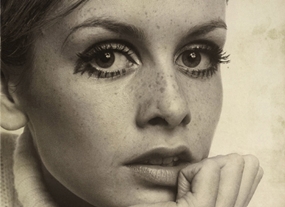Anyone who is known to enjoy the pastime of photography will, one day, be asked to take somebody’s photo – and by that, they don’t mean a passport picture, they mean a portrait that can be hung on the wall as a veritable family heirloom.
There are enormous differences between pictures and portraits. The two styles of resulting photographs are poles apart. You see, ‘portraits’ comes from the word ‘portray’ and means to make a likeness of. Portraiture is even described as the ‘art’ of making that likeness, and that is where the difference comes.
 Portrait of Twiggy by Cecil Beaton.
Portrait of Twiggy by Cecil Beaton.
We have all got, or have seen, passport photographs. These are the archetypal picture. They show what your face looks like. Nothing more, nothing less, and all against a blue background, with the sitter square on to the camera.
However, when you have a portrait taken, the photograph should do more than just show what your face looks like, but also give some inkling as to what you are like. Sort of ‘value-added’ if you will. I describe it as making a likeness of the ‘person’. Somehow you have to get the personality into the picture, and that way you have a real portrait.
It is for this reason alone that you cannot walk into a suburban photo studio and get your “portrait” taken. At best you will get an adequately lit picture of yourself. You will not get a portrait.
For the photographer to understand the sitter takes time in getting to know the sitter. Likes and dislikes, hobbies, anxieties, a wife or mother – a whole thumbnail sketch of the person, and then and only then, should the sitter get in front of the camera.
So let’s make you, the weekend photographer, into a portrait photographer. To portray the person, you first need to know how the sitters perceive themselves. People who consider themselves to be happy, spontaneous people should be photographed laughing, head back, open mouthed, smiling, tossing the hair around – you get the concept, I’m sure. More studious people should be shown in that manner. A book as a prop is a great idea to convey the mood and make the sitter feel relaxed. Having already found out a little of the sitter’s likes and dislikes, you can also add some props, and have the subject begin to relate to them, like the book in the studious portrait. This also helps them to relax.
I have mentioned before in this column that the first rule with all sitters is to get your subject to relax. If your favorite lady is sitting rigidly staring at the camera as Thai people seem to do, I can guarantee that the end result will not be pleasing to either the sitter or the photographer. When making a portrait of Thai people in particular, it is even more important to get them relaxed and happy, as they do tend to “stand to attention” with arms held straight at their sides, looking as if they are on army parade.
The pose to avoid at all costs is the subject straight on to the camera. This is unfortunately the commonest pose – but it is the most un-glamorous pose, especially as far as women are concerned. That is why it is used in passports!
Here’s what to do to get over this problem. Start by sitting your lady in a chair, and then turn it 45 degrees away from the straight ahead position. Now ask her to slowly turn her head and look at the end of your camera’s lens. Look through your viewfinder – see? It looks better already. Now ask her to gently raise the shoulder closest to the camera and smile. Guess what? You are starting to get a portrait image.
That basic pose can be modified by turning to the left as well as to the right, shoulders up or down, open mouthed smile or shy grin. Each shot will have a different look. Try to get the subject relaxed by talking to them, cracking jokes or anything that will get them to relax. From there you try to get the personality of the sitter to come through.
Have a go at portrait photography this weekend.




